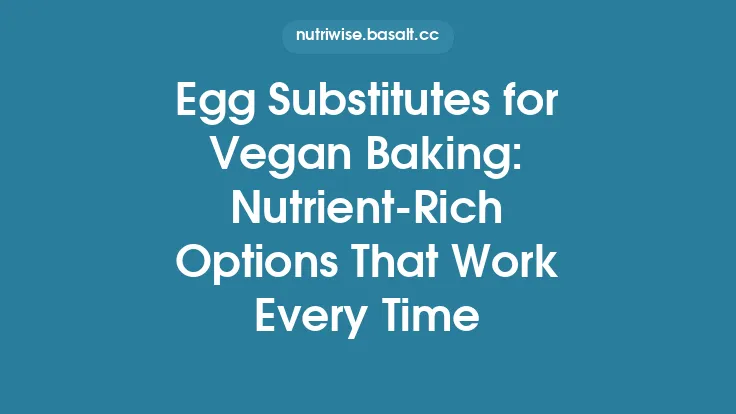Baking at home often feels like a race against the clock. Fresh dairy, eggs, and ripe fruit can disappear from the pantry in a matter of days, leaving you with a half‑finished recipe or a sudden craving you can’t satisfy. The good news is that a well‑stocked pantry of shelf‑stable ingredients can bridge that gap, allowing you to create nutritious baked goods whenever the mood strikes—without sacrificing flavor, texture, or nutritional value. Below, we explore the most versatile, long‑lasting substitutes, explain how they work on a chemical level, and provide practical strategies for integrating them into your everyday baking routine.
Understanding Shelf‑Stable Basics
Shelf‑stable ingredients are foods that retain their safety, quality, and nutritional profile for months—or even years—when stored under proper conditions (cool, dry, and airtight). Their longevity stems from one or more of the following preservation methods:
| Preservation Method | How It Extends Shelf Life | Typical Shelf Life |
|---|---|---|
| Dehydration (removing water activity) | Lowers water activity (a<sub>w</sub>) to inhibit microbial growth | 12–24 months |
| Canning/Pressure Cooking (heat‑sterilization in sealed containers) | Destroys microorganisms and creates a vacuum seal | 1–5 years |
| Spray‑drying / Freeze‑drying (converting liquids to powders) | Removes moisture while preserving nutrients | 2–5 years |
| Acidification & Sugar Preservation (high acidity or sugar concentration) | Creates an environment hostile to spoilage organisms | 6–12 months |
| Packaging in Inert Atmosphere (nitrogen flushing) | Reduces oxidation and rancidity | 12–24 months |
Understanding these mechanisms helps you predict how an ingredient will behave in a batter or dough. For instance, powdered milk rehydrates quickly because the milk proteins have already been denatured by spray‑drying, making them readily soluble. Conversely, dehydrated fruit retains its natural sugars and pectin, which can contribute both sweetness and structure when rehydrated.
Milk and Dairy Alternatives That Last
1. Powdered Milk (Whole, Skim, or Low‑Fat)
- Why It Works: Spray‑drying concentrates milk proteins (casein and whey) and lactose, creating a fine, shelf‑stable powder. When reconstituted, it mimics fresh milk’s emulsifying and browning properties.
- Baking Benefits: Provides the Maillard reaction for golden crusts, contributes to crumb tenderness, and adds calcium and vitamin D.
- Usage Tips: Dissolve 1 cup of powder in 1 cup of water for a 1:1 milk substitute. For richer results, use a higher powder‑to‑water ratio (e.g., 1 ½ cups powder per cup water) to emulate whole milk.
2. Shelf‑Stable Plant‑Based Milks (UHT‑Processed)
- Why It Works: Ultra‑high temperature (UHT) processing sterilizes the milk, allowing it to be stored unopened at room temperature for up to 6 months.
- Baking Benefits: Almond, soy, oat, and rice milks each bring distinct flavor notes and fat contents. For example, oat milk’s higher carbohydrate content can aid browning, while soy milk’s protein contributes to structure.
- Usage Tips: Shake well before use to re‑emulsify any settled fats. Substitute 1:1 for dairy milk in most recipes.
3. Coconut Cream (Canned)
- Why It Works: The high fat content (≈20 %) and low water activity of canned coconut cream make it resistant to spoilage.
- Baking Benefits: Adds moisture, richness, and a subtle coconut aroma. The saturated fats help create tender crumb and improve shelf life of the final product.
- Usage Tips: Chill the can, scoop out the solidified cream, and whisk to a smooth consistency. Use ¼ cup for every ¼ cup of butter or oil you wish to replace.
Powdered Eggs and Their Applications
While fresh eggs are a staple for leavening, binding, and emulsifying, powdered eggs offer a reliable, long‑lasting alternative.
- Composition: Whole‑egg powders contain dried yolk and white, preserving the balance of proteins, lipids, and emulsifiers (lecithin). Some varieties are pasteurized for added safety.
- Functional Role: Egg proteins coagulate upon heating, providing structure; yolk lipids contribute to richness and emulsification.
- Reconstitution Ratio: Typically, 1 large egg ≈ 1 tablespoon (≈ 15 g) of powdered egg mixed with 2 tablespoons (≈ 30 ml) of water. Adjust for specific brands by consulting the label.
- Special Considerations: Because the powder lacks the natural moisture of fresh eggs, you may need to increase the overall liquid in the recipe by 1–2 tablespoons to maintain batter consistency.
Canned and Dehydrated Produce for Moisture and Nutrition
1. Canned Pumpkin or Sweet Potato Puree
- Why It Works: The canning process preserves the natural sugars, fiber, and pectin, which act as humectants and stabilizers.
- Baking Benefits: Adds moisture, subtle sweetness, and a tender crumb without the need for fresh produce. The beta‑carotene contributes vitamin A.
- Usage Tips: Replace up to ½ cup of butter or oil with an equal amount of puree for a lighter texture. For a more pronounced flavor, combine with complementary spices (cinnamon, nutmeg).
2. Dehydrated Fruit (e.g., raisins, dried apricots, dried cherries)
- Why It Works: Low water activity prevents microbial growth, while natural sugars are concentrated.
- Baking Benefits: Provides bursts of sweetness, chewiness, and additional micronutrients (iron, potassium). The natural pectin can aid in gel formation, improving crumb structure.
- Rehydration Method: Soak in warm water, tea, or a flavored liquid (e.g., orange juice) for 10–15 minutes, then drain and pat dry before folding into batter.
3. Freeze‑Dried Vegetables (e.g., carrots, beetroot)
- Why It Works: Freeze‑drying removes water while preserving cell structure and nutrients.
- Baking Benefits: Adds color, subtle flavor, and micronutrients without adding extra moisture. When ground into a fine powder, they can serve as natural colorants or flavor enhancers.
- Usage Tips: Grind to a powder using a food processor and incorporate 1–2 tablespoons into the dry mix for added nutrition.
Shelf‑Stable Sweeteners and Their Role in Healthful Baking
Even though the focus of this article isn’t sugar reduction, it’s worth noting that certain shelf‑stable sweeteners can provide a more balanced glycemic response while still delivering the sweetness needed for baked goods.
- Maltitol and Erythritol (Sugar Alcohols): Stable at room temperature, they mimic sugar’s bulk and crystallization properties, making them suitable for cookies and brownies. They have minimal impact on blood glucose.
- Coconut Sugar: A minimally processed, shelf‑stable sweetener that retains trace minerals (iron, zinc). It caramelizes similarly to brown sugar, adding depth of flavor.
- Date Sugar: Made from dehydrated, ground dates, it offers natural sweetness and a slight fruity note. Because it contains fiber, it can modestly improve the nutritional profile of muffins and quick breads.
Practical Tip: When substituting a granulated sweetener with a sugar alcohol, use a 1:1 ratio but reduce the liquid by 1–2 tablespoons to compensate for the lower hygroscopicity.
Long‑Lasting Fats and Oils for Texture and Flavor
1. Refined Coconut Oil (Solid at Room Temperature)
- Why It Works: High saturated fat content (≈ 90 %) makes it resistant to oxidation, giving it a shelf life of 2 years or more.
- Baking Benefits: Provides a buttery mouthfeel and contributes to a crisp crust. Its neutral flavor (when refined) won’t dominate the final product.
- Usage Tips: Melt and cool to the same temperature as butter before substituting 1:1.
2. Shelf‑Stable Nut Butters (e.g., almond, peanut)
- Why It Works: Low water activity and natural antioxidants (vitamin E) extend shelf life.
- Baking Benefits: Adds protein, healthy fats, and a subtle nutty flavor. The natural emulsifiers in nut butters improve batter stability.
- Usage Tips: Stir well before measuring to recombine any oil separation. Replace up to ¼ cup of butter with an equal amount of nut butter for added richness.
3. Ghee (Clarified Butter)
- Why It Works: Removal of milk solids eliminates the primary source of spoilage, allowing storage at room temperature for up to 6 months.
- Baking Benefits: Delivers a deep, buttery flavor and a high smoke point, making it ideal for recipes that require browning.
- Usage Tips: Use 1:1 for butter in recipes where a slightly richer flavor is desired.
Stabilizers, Thickeners, and Binders from the Pantry
1. Cornstarch and Arrowroot Powder
- Function: Both are starches that gelatinize when heated with liquid, providing structure and moisture retention.
- Application: Use 1 tablespoon per cup of flour to increase tenderness in cakes or to thicken fruit fillings without adding extra fat.
2. Instant Pudding Mix (Unflavored)
- Function: Contains modified starches and emulsifiers that improve crumb softness and extend shelf life.
- Application: Add ½ cup to a standard cake batter for a moister, more stable crumb.
3. Xanthan Gum (Small Quantities)
- Function: A polysaccharide that forms a viscous network, improving elasticity and preventing crumb collapse.
- Application: For gluten‑free or low‑protein recipes, add ¼ teaspoon per cup of flour to mimic the binding properties of gluten.
Practical Tips for Managing Your Shelf‑Stable Baking Arsenal
- Rotate Stock Regularly – Adopt a “first‑in, first‑out” system. Label containers with purchase dates and set a reminder to use older items before newer ones.
- Store in Cool, Dark Places – Light and heat accelerate oxidation, especially for oils and nut butters. A pantry with a temperature below 75 °F (24 °C) is ideal.
- Use Airtight Containers – Transfer bulk items (powders, nuts, dried fruit) into vacuum‑sealed jars or Mylar bags with oxygen absorbers to maximize longevity.
- Keep a “Baking Cheat Sheet” – List each shelf‑stable ingredient, its reconstitution ratio, and typical substitution equivalents. This speeds up decision‑making when you’re in a hurry.
- Test Small Batches – When trying a new substitute, bake a mini‑batch first. Observe texture, rise, and flavor before scaling up.
- Mind the Moisture Balance – Shelf‑stable ingredients often lack the water content of fresh counterparts. Adjust the overall liquid in the recipe accordingly to avoid dry or overly dense results.
Sample Recipes Using Shelf‑Stable Substitutes
1. Coconut‑Oil Banana Bread (All Shelf‑Stable)
Ingredients
- 1 ½ cups all‑purpose flour
- ½ cup powdered milk (reconstituted with ½ cup water)
- ¼ cup coconut sugar
- 1 tsp baking soda
- ½ tsp salt
- ¼ cup coconut oil, melted
- ¼ cup canned pumpkin puree
- 2 large eggs (or 2 tbsp powdered egg + 4 tbsp water)
- ½ cup dried banana chips, finely chopped
- 1 tsp vanilla extract (optional)
Method
- Preheat oven to 350 °F (175 °C). Grease a 9×5‑inch loaf pan.
- In a bowl, whisk together flour, reconstituted milk, coconut sugar, baking soda, and salt.
- In a separate bowl, combine melted coconut oil, pumpkin puree, eggs (or reconstituted powder), and vanilla.
- Fold wet ingredients into dry until just combined. Gently stir in chopped banana chips.
- Pour batter into the pan and bake 45–50 minutes, or until a toothpick inserted in the center comes out clean.
- Cool on a wire rack before slicing.
Why It Works: The coconut oil provides a stable fat source, pumpkin puree adds moisture and natural sweetness, and powdered milk supplies protein and browning. Dried banana chips contribute flavor without the perishability of fresh bananas.
2. Nut‑Butter Oatmeal Cookies (Shelf‑Stable)
Ingredients
- 1 cup rolled oats (store‑bought, shelf‑stable)
- ½ cup all‑purpose flour
- ¼ cup refined coconut oil, solid
- ¼ cup almond butter (stirred)
- ¼ cup coconut sugar
- 1 egg (or 1 tbsp powdered egg + 2 tbsp water)
- ½ tsp baking powder
- ¼ tsp salt
- ½ tsp cinnamon (optional)
Method
- Preheat oven to 325 °F (165 °C). Line a baking sheet with parchment.
- Cream together solid coconut oil, almond butter, and coconut sugar until smooth.
- Add the egg (or reconstituted powdered egg) and mix well.
- In a separate bowl, whisk flour, oats, baking powder, salt, and cinnamon.
- Combine wet and dry mixtures, stirring just until incorporated.
- Scoop tablespoonfuls onto the sheet, flatten slightly, and bake 12–14 minutes.
- Allow cookies to cool on the sheet for 5 minutes before transferring to a rack.
Why It Works: The combination of solid coconut oil and almond butter creates a stable fat matrix that yields a chewy texture. Oats and flour provide structure, while the powdered egg ensures binding without fresh eggs.
By strategically incorporating these shelf‑stable ingredients, you can maintain a nutritious, flexible baking repertoire that isn’t limited by the calendar. The pantry becomes a reliable laboratory where healthful, delicious treats are always within reach—rain or shine, weekday or weekend. Happy baking!





